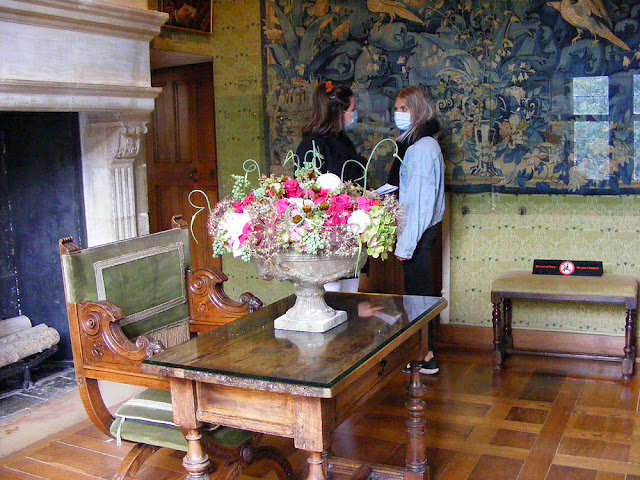Recently a tapestry has returned to the Chateau de Chenonceau after having been away for months.
It is known as 'A l'Aristoloche' and is one of a number of tapestries woven in the late 15th century in the Oudenaarde (Audenarde) area of Flanders featuring a European interpretation of the leaves and flowers of the newly discovered and thoroughly exotic South American vines Aristolochia spp. Earlier versions of this style of tapestry are dubbed 'cabbage leaf' tapestries because of the lush big leaves that feature throughout the design. So there is a sort of merging of European and exotic flora in order to create these once verdant textiles.
Detail of the newly conserved A l'Aristoloche tapestry at the Chateau of Chenonceau.
I say once verdant because when they left the tapestry weaver's atelier these works would have been a riot of many shades of green. Now they are predominantly blue, as their natural plant based dyes have aged differently. What you see now is indigo, from the woad plant, a very strong and fast dye. But originally it would have been overdyed with dyers greenweed, which produces yellow and the effect would have been green. The yellow has now faded and we just left with the blue.
There is an Aristolochia native to Europe but although curious looking, it is nowhere near as striking as its South American cousins. I don't know if the European tapestry weavers were aware that the tropical vine they were doing their best to interpret from sketches or even just written descriptions had a local version. In any case, with the Aristolochia tapestries the important thing was to make them as exotic and lush as possible. In reality, Aristolochia spp leaves are usually large, flat and heart shaped, although they do vary a bit from species to species. The flowers are tubes which turn up at the ends into a bowl shape, leading to one of their vernacular names, "dutchman's pipe".
The A l'Aristoloche tapestry hangs in Catherine de Medici's private apartments at the Chateau of Chenonceau. Photo from just prior to the tapestry's conservation restoration.
In the case of the tapestry at Chenonceau it also includes depictions of other South American flora and fauna. Columbus was just back from the New World and there was great excitement amongst the merchant classes as they imagined what they might be able to trade in and how much money they might make. The tapestry features Hoatzins (birds that look like scruffy crested pheasants), tropical fruits and epiphytic orchids, all unknown to Europe prior to the 1490s. But there are also traditional European fruits and flowers included, perhaps to deliver certain specific messages, such as pomegranates for fertility, prosperity and abundance, or lilies for virtue and once again, fertility. The European species of Aristolochia is known as "birthwort" because of the flower's resemblance to the birth canal, so perhaps after all, the tapestry weavers did know that the European and American plants were connected.
But there is a less obvious symbolism associated with this tapestry and the many like it. Columbus's return from the New World was widely heralded as him having rediscovered the Garden of Eden, so on one level this tapestry is a representation of the beauty of God's Creation in a relatively obvious way. Ironically, given the influence of the ascetic mystic Savonarola and his bonfires of the vanities as a ritual to rid the world of sin, this luxury object and its idea of the Garden of Eden is also connected to a more widespread developing belief that the world was about to end. In this way of thinking, Columbus's rediscovery of the Garden of Eden was a signifier or precursor to the End Times, and many wealthy people were preparing themselves for the event by commissioning works of art which showed that they acknowledged God's power and were ready to submit to God's rule. These sorts of subtle, multi-layered messages contained in decorative works are very typical of the decades around 1500 in France.
The tapestry has no historical connection to the Chateau of Chenonceau or any of its owners as far as I know. I assume it was bought at auction in Paris in the mid-twentieth century by Gaston Menier, then the owner of the chateau. He amassed a museum quality collection to set dress his chateau and entice the general public in to see it decked out as it might have been in its sixteenth century heyday.
For the entirety of the tapestry's absence it was represented by a lifesize high definition photograph on a sheet of vinyl hanging on the wall. Curators do this sometimes so there isn't an awkard gap in the display. There is no active attempt to deceive the visitor but my guess is that the majority of people never realised they were not looking at a real tapestry. I certainly saw people faithfully photographing the 'fake' with every indication that they thought it was the real thing.



No comments:
Post a Comment